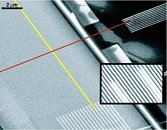Monday, January 29th 2007
Memory Circuits the Size of a White Blood Cell
Chemists from UCLA and the California Institute of Technology have managed to create an ultra-dense memory device capable of storing 100 Gb (gigabits) per square centimetre, an accomplishment which could lead to much smaller and more powerful computers than we have today. The memory uses a series of perpendicular nanowires crossing over each other, with 400 silicon wires crossed by 400 titanium wires, both 16nm wide. At each crossing are approximately 300 bistable rotaxane molecules which can act as switches and therefore be used to store data in a very small space.
Source:
DailyTech

9 Comments on Memory Circuits the Size of a White Blood Cell
i love technology
Essentially it has tiny bits of wire crossing each other and stores data at the exact points where they cross. I think.
Bistable meaning here molecules that have to stable states so 1 & 0. Basicly the wires are there just to hold the rotaxane molecules in plaze, which store the actual data. Well that and to transmit the state of the molecules. How they do that and how come there are 300 of them in one crossing goes over my head xD Can't grasp something so tiny working, so I'll join the list :)
If I'd have to guess more, the titanium wires are there to offer structural stability and silicon wires act as semiconductors whose electrical conductivity those rotaxane molecules alter. But I really don't know =)
try reading the entire article, will make you smarter